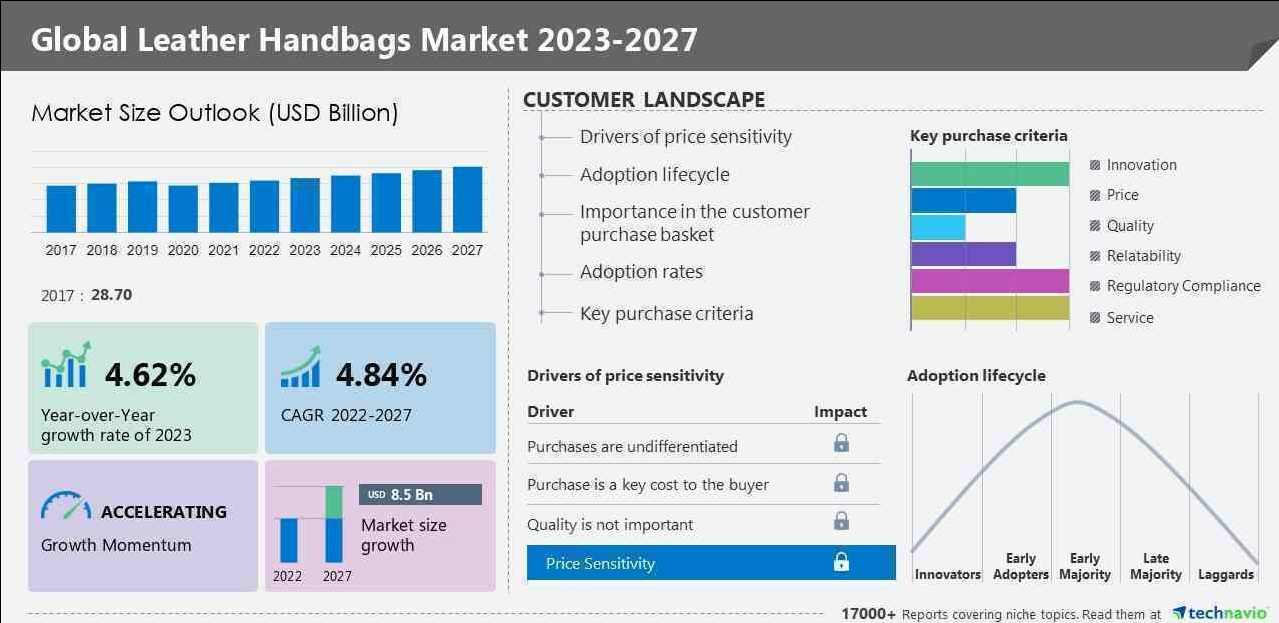From 2023 to 2027, the global leather handbag market size is expected to grow by USD 8.5 billion. The market is expected to grow at a CAGR of 4.84% during the forecast period. In 2022, Asia-Pacific accounted for the largest share of the global market, and the market in the region is expected to grow by 32%.
The Asia-Pacific region is expected to play a key role in driving the global leather handbag market

Research analysis
In the context of rapid globalization, the leather handbag market for young people is experiencing significant growth. Consumers' consumption of high-quality leather handbags as fashion accessories reflects their lifestyle and consumption behavior. The continued inclusion of women in the workforce has led to an increased demand for durable and long-lasting compartment handbags that fit the needs of their occupation. Comprehensive surveys show that American women prefer leather handbags over fabric handbags due to their durability and investment value. Leather materials, such as raw hides and processed leathers, are in high demand in this sector. Handmade leather accessories emphasize high-quality craftsmanship and designer pieces and are a popular fashion statement. The leather handbag segment and the fabric handbag segment are different markets, with the former focusing on luxury and investment, while the latter caters to more casual and affordable consumer preferences. Online distribution channels are becoming increasingly important to reach consumers, especially those who value convenience and variety. In conclusion, the leather handbag market is driven by consumers' preference for durability, longevity, and value for investment, as well as their desire for high-quality, trendy accessories.
Market drivers
The leather handbag market is growing significantly due to fashion consciousness and the demand for customized and personalized products. Leading market players in the luxury sector are enhancing their product portfolios by customizing leather handbags, incorporating precious metals, gemstones, and personalized embellishments. Traditional handbags are being redesigned with affordable leather options to cater to a wider consumer base. Product improvement and technological innovation are key focus areas, with social platforms and e-commerce companies driving sales. Startups are disrupting the market with handmade accessories and niche applications. Brand recognition and value chain optimization are critical to market success. Raw material prices, trade regulations, and production analysis are the key factors influencing the market. Emerging revenue streams include working women and the handbag sector. Consumer preferences for fashion statements, quality, craftsmanship, and longevity continue to drive demand. Killing animals remains a controversial issue for luxury consumers. Product approvals, releases, and application dominance are shaping the market landscape.
Market Overview
The leather handbag market is an important part of the global fashion industry. Consumers prefer leather handbags because they are durable, stylish, and versatile. The production process involves multiple stages, including tanning, cutting, stitching, and assembly. The raw materials used are mainly cowhide, sheepskin and goatskin. The market is driven by factors such as rising disposable income, increasing urbanization, and changing consumer preferences. Brands such as Ralph, Comfortable, and Fashionable offer a variety of leather handbags that cater to different budgets and styles. There is also a growing consumer awareness of ethical and sustainable production practices, leading to an increase in demand for eco-friendly leather handbags. The market is expected to grow steadily in the coming years, with Asia-Pacific emerging as a major contributor due to its large population and economic growth.

Scan to wechat:
